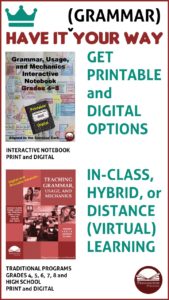Grammar Digital Programs
Grammar, usage, and mechanics (punctuation, capitalization, spelling, quotations, citations, etc.) are ideal subjects for distance learning (virtual learning). The teacher can ZOOM, Google Meet, Microsoft Teams, etc. the lesson content, and students can use Google slides for interactive practice of the lesson content, concept, and skill. Google forms self-correcting tests can serve as formative assessments (unit tests), and any necessary remediation can be assigned via additional slides practice.
Teachers can record videos to provide repetition and additional practice for remediation.
In other words, distance learning works nicely to help students catch up, while they keep up with grade-level instruction.
I highly recommend Pennington Publishing’s full-year Teaching Grammar, Usage, and Mechanics Grades 4, 5, 6, 7, 8 and High School programs. (After all, I’m the author 🙂 These separate, standards-based programs are rigorous, yet have plenty of remedial practice to help students who don’t have much of a grammar background. The print and digital resources feature 56 (64 for high school) , twice-per-week, 25-minute lessons to help you teach both mechanics (punctuation, capitalization, quotations, etc.) and grammar and usage skills and concepts.
————————————————————————————————————————————————————————————————–
Click to view the quick Grade 4 Video Preview.
Click to view the quick Grade 5 Video Preview.
Click to view the quick Grade 6 Video Preview.
Click to view the quick Grade 7 Video Preview.
Click to view the quick Grade 8 Video Preview.
Click to view the quick High School Video Preview.
————————————————————————————————————————————————————————————————–
Each grade-level program has been designed for both in-class and distance learning with printable PDFs and Google slides, forms, and sheets. If you prefer teaching with PowerPoint, simply download the slides into that format. As the Burger King commercial says, “Have it your way.”
How to teach the 56 (64 for high school) scripted, no-prep, and minimal-correction lessons:
- Administer the diagnostic assessment to determine mastery of previous grade-level standards (Google forms with Google sheets recording matrix).
- Use the scripted lesson and lesson display in the teacher’s guide (PDFs) to teach the paired mechanics and grammar lessons in-class or via Zoom, etc.
- Students complete and self-correct the guided practice, slide activities, simple sentence diagram, mentor text, writing applications, and sentence dictation formative assessments (Google slides and PDFs)
- Assign additional independent practice if needed to all or some students (Google slides and PDFs).
- After completing four of the lessons, administer the biweekly unit test (Google forms). Administer the final exam at the end of the year (Google forms with Google sheets recording matrix).
The Teaching Grammar, Usage, and Mechanics program features a secret agent theme in the Google slides with drag and drop activities, type-in-the-box practice, audio files, and problem-solving (secret codes and such). The theme is fun, but the learning tasks are rigorous.
Click to view the Grades 4-8 Instructional Scope and Sequence (table of contents) with CCSS Alignment Documents. The Teaching Grammar, Usage, and Mechanics program provides effective grade to grade instructional continuity.
————————————————————————————————————————————————————————————————–
or… Also check out the Grammar, Usage, and Mechanics Interactive Notebook Grades 4-8.
*****

Pennington Publishing Grammar Programs
Teaching Grammar, Usage, and Mechanics (Grades 4, 5, 6, 7, 8, and High School) are full-year, traditional, grade-level grammar, usage, and mechanics programs with plenty of remedial practice to help students catch up while they keep up with grade-level standards. Twice-per-week, 30-minute, no prep lessons in print or interactive Google slides with a fun secret agent theme. Simple sentence diagrams, mentor texts, video lessons, sentence dictations. Plenty of practice in the writing context. Includes biweekly tests and a final exam.
Grammar, Usage, and Mechanics Interactive Notebook (Grades 4‒8) is a full-year, no prep interactive notebook without all the mess. Twice-per-week, 30-minute, no prep grammar, usage, and mechanics lessons, formatted in Cornell Notes with cartoon response, writing application, 3D graphic organizers (easy cut and paste foldables), and great resource links. No need to create a teacher INB for student make-up work—it’s done for you! Plus, get remedial worksheets, biweekly tests, and a final exam.
Syntax in Reading and Writing is a function-based, sentence level syntax program, designed to build reading comprehension and increase writing sophistication. The 18 parts of speech, phrases, and clauses lessons are each leveled from basic (elementary) to advanced (middle and high school) and feature 5 lesson components (10–15 minutes each): 1. Learn It! 2. Identify It! 3. Explain It! (analysis of challenging sentences) 4. Revise It! (kernel sentences, sentence expansion, syntactic manipulation) 5. Create It! (Short writing application with the syntactic focus in different genre).
Get the Diagnostic Grammar, Usage, and Mechanics Assessments, Matrix, and Final Exam FREE Resource:
![]()
